As devoted pet parents, we strive to provide our canine companions with the best nutrition possible. However, the line between safe and dangerous human foods can be incredibly blurry, and some common household items can pose serious health risks to our dogs. While many human foods are perfectly healthy and even beneficial for dogs, others can be outright toxic, even in small quantities. Understanding what foods to avoid is paramount to ensuring your dog’s safety and well-being. This guide will delve into the crucial question of What Is The One Meat You Should Never Feed Dogs, alongside other vital dietary information to keep your furry friend safe and healthy.
More than 401,500 pet poisonings occur in the United States annually. While not all are food-related, human foods are a significant contributor. Armed with the right knowledge about foods to steer clear of and what foods dogs can safely eat, you can act as a vigilant guardian of your dog’s health.
Why Certain Human Foods Are Toxic to Dogs
Canine digestion and metabolism are fundamentally different from our own. This disparity means that what is harmless to us can be detrimental, even fatal, to our dogs. Their bodies process certain compounds in ways that can lead to rapid accumulation and severe health consequences.
For instance, dogs metabolize theobromine and caffeine found in chocolate much slower than humans. This can lead to dangerous buildup in their system. Similarly, while cherries are safe in moderation, their pits, stems, and leaves contain cyanide. Furthermore, hard pits can cause digestive blockages. The toxicity of a food can also be influenced by a dog’s size, breed, and underlying health conditions, underscoring the importance of consulting your veterinarian with any dietary concerns.
The Meat That is Absolutely Off-Limits for Dogs
While many human foods are dangerous, when it comes to meat, there is one category that stands out as particularly hazardous and should never be fed to dogs: raw or undercooked meat.
This category includes raw beef, chicken, pork, lamb, and any other raw animal flesh. The primary concern with raw meat is the potential presence of harmful bacteria such as Salmonella and E. coli. While these pathogens can affect humans, dogs are also susceptible to severe gastrointestinal distress and infections from them. Symptoms can range from vomiting and diarrhea to more serious systemic illnesses.
Beyond bacterial contamination, raw meat can also pose a choking hazard or lead to internal injuries if bones are present. Bones, especially when raw, can splinter and cause damage to the throat, stomach, or intestines. This can result in blockages, perforations, and potentially fatal infections.
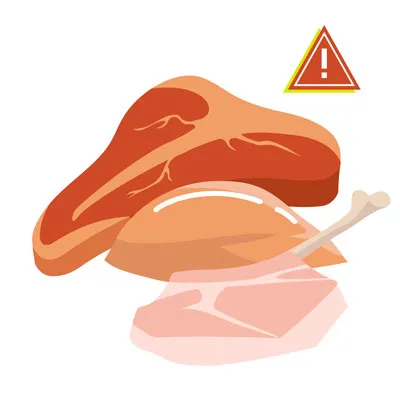 Raw meat being prepared
Raw meat being prepared
Therefore, always ensure that any meat you prepare for your dog is thoroughly cooked, free of bones, and devoid of any seasonings, oils, or additives that could be harmful.
A Comprehensive List of Foods Your Dog Should Never Eat
Understanding that raw meat is a critical item to avoid, let’s explore other common human foods that pose a significant risk to dogs. It’s important to remember that this list is not exhaustive, and it’s always best to err on the side of caution. If you’re unsure about a food, it’s best to avoid giving it to your dog.
1. Alcohol
Even small amounts of alcohol can have a devastating effect on dogs due to their smaller size and different metabolism. Symptoms can include vomiting, breathing difficulties, coma, and even death.
2. Apple, Apricot, Cherry, and Plum Seeds/Pits
While the flesh of these fruits may be safe, their seeds and pits contain cyanide. Ingestion can lead to serious health issues, including irregular heartbeat, seizures, and death. The pits also present a choking hazard and can cause intestinal blockages.
3. Avocado
Avocados contain persin, which can cause gastrointestinal upset in dogs. The pit also poses a significant obstruction risk in the digestive tract.
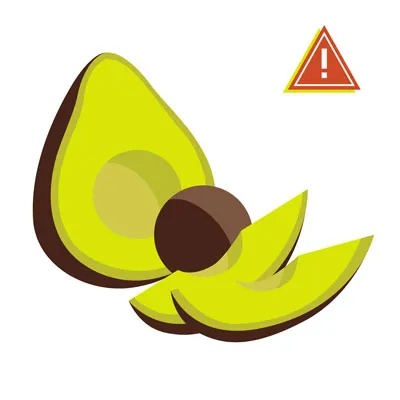 A whole avocado
A whole avocado
4. Broccoli
In large quantities, the isothiocyanates in broccoli can be toxic to dogs. While small amounts may be acceptable occasionally, the stalks can also be a choking hazard.
5. Caffeine and Coffee Grounds
Methylxanthines in caffeine can cause severe vomiting, diarrhea, seizures, and heart arrhythmias in dogs.
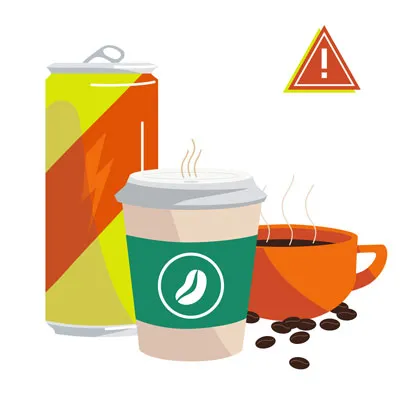 Coffee beans and grounds
Coffee beans and grounds
6. Chocolate
Chocolate contains theobromine and caffeine, which dogs cannot metabolize effectively. Darker and baker’s chocolate are particularly dangerous. Symptoms range from hyperactivity and vomiting to seizures and heart failure.
7. Grapes and Raisins
These fruits can cause sudden and severe kidney failure in dogs, even in small quantities. Vomiting, diarrhea, and loss of appetite are common symptoms.
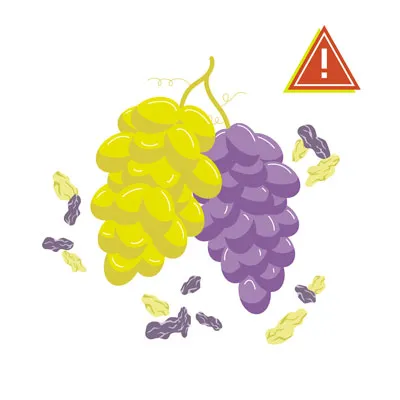 A bunch of grapes
A bunch of grapes
8. Macadamia Nuts, Almonds, and Pistachios
Macadamia nuts are particularly toxic, causing weakness, vomiting, and tremors. Other nuts can be choking hazards or problematic due to added seasonings. You can learn more about what foods you should never feed your dog to avoid these dangers.
9. Milk and Dairy Products
Many dogs are lactose intolerant, leading to digestive issues like gas and diarrhea. High-fat dairy products can also contribute to pancreatitis.
10. Mushrooms
Various toxins in mushrooms can lead to liver and kidney failure, vomiting, diarrhea, and even hallucinations. It’s best to avoid all types of mushrooms.
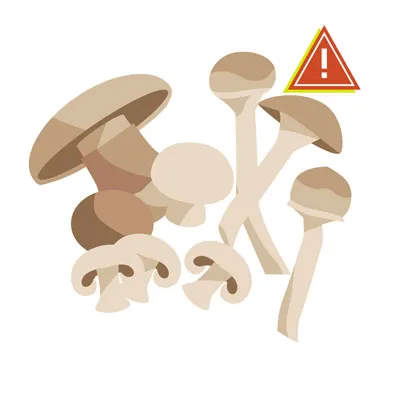 A variety of mushrooms
A variety of mushrooms
11. Nutmeg and Cinnamon
Nutmeg can cause hallucinations and severe vomiting. Cinnamon can irritate a dog’s mouth and potentially lead to low blood sugar.
12. Onions, Garlic, Chives, and Leeks
These allium plants contain compounds that damage red blood cells, leading to anemia. Onion and garlic powders are often found in processed foods, so always read labels.
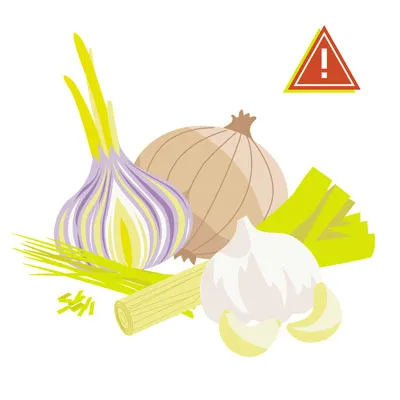 Onions and garlic bulbs
Onions and garlic bulbs
13. Salt
Excessive salt intake can disrupt a dog’s fluid balance, leading to tremors, seizures, diarrhea, and even coma.
14. Spicy Food
Spicy foods can cause significant gastrointestinal upset, including vomiting, diarrhea, and stomach ulcers.
15. Sugar-Free Gum and Candy (Xylitol)
Xylitol is an artificial sweetener found in many sugar-free products. It can cause a rapid drop in blood sugar and liver failure in dogs, often leading to seizures. Be particularly careful with sugar-free baked goods.
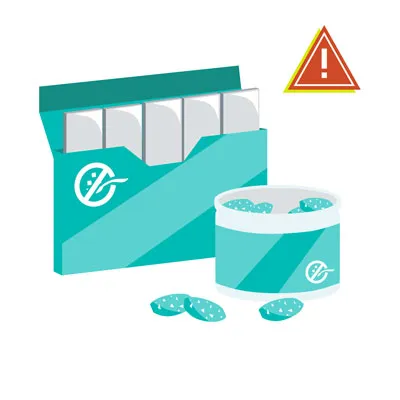 Sugar-free candy and gum
Sugar-free candy and gum
16. Tomatoes and Raw Potatoes
The green parts of tomato plants and unripe tomatoes, as well as raw potatoes, contain solanine, which is toxic to dogs. Cooked potatoes without additives are generally safe in moderation.
17. Tobacco
Nicotine in tobacco products is highly toxic to dogs, causing vomiting, diarrhea, seizures, and potentially death.
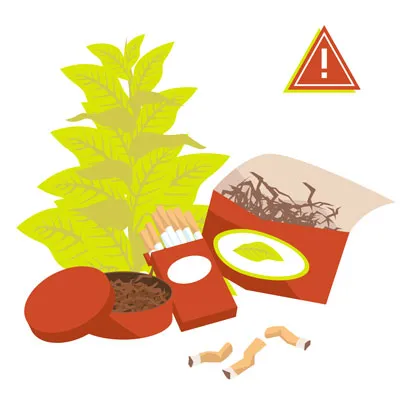 A packet of cigarettes
A packet of cigarettes
18. Yeast and Raw Dough
Raw dough can expand in a dog’s stomach, causing severe pain and potentially life-threatening torsion. The fermentation process also produces alcohol, leading to alcohol poisoning.
19. Rhubarb and Star Fruit
Both rhubarb and star fruit contain soluble calcium oxalate crystals, which can lead to dangerously low calcium levels and renal failure.
20. Flavored Water and Seltzer Water
Stick to plain, fresh water. Flavored and carbonated waters can contain added sugars, salts, or artificial ingredients that are harmful to dogs.
Understanding the Risks: Dogs Most Vulnerable to Toxic Foods
While any dog can be negatively affected by ingesting toxic foods, certain groups are at a higher risk:
- Small Breeds: Their lower body weight means a smaller amount of a toxic substance can have a more significant impact.
- Puppies: Their digestive and immune systems are still developing, making them more susceptible to food-related illnesses.
- Elderly Dogs: Older dogs may have pre-existing health conditions that make them more vulnerable.
- Dogs with Pre-existing Conditions: Chronic illnesses like diabetes or kidney disease can exacerbate the effects of toxic foods. Understanding what foods dogs can not digest is crucial for these dogs.
Preventing Your Dog from Consuming Toxic Foods
Prevention is key when it comes to protecting your dog from harmful human foods.
- Secure Storage: Keep all potentially toxic foods stored in high cabinets, pantries, or refrigerators where your dog cannot reach them.
- No Feeding from the Table: Never feed your dog directly from your plate or while you are cooking. This teaches them to beg and can lead to them scavenging for scraps. Always provide treats specifically made for dogs.
- Educate Your Household and Guests: Ensure everyone in your home, including children and visitors, understands which foods are dangerous for your dog and the importance of not sharing human food.
- Holiday Vigilance: Holidays are a prime time for accidental ingestions due to increased food preparation and potential distractions. Be extra cautious during these periods.
What to Do If Your Dog Eats Something Toxic
Accidents can happen. If you suspect your dog has ingested a toxic food, immediate action is critical:
- Contact Your Veterinarian or Pet Poison Control Immediately: Time is of the essence. Prompt medical attention significantly increases the chances of a successful recovery.
- Provide Essential Information: Be prepared to tell the professional what food was ingested, the approximate amount, and the time of ingestion.
- Avoid Home Remedies: Do not attempt to induce vomiting or administer any home remedies unless specifically instructed by a veterinarian. Certain substances can cause more harm if vomited.
Ensuring Your Dog’s Dietary Safety
Navigating the complexities of canine nutrition and identifying unsafe human foods can be challenging. However, by staying informed and vigilant, you can significantly reduce the risk of your dog encountering harmful substances. Remember that beyond the list of dangerous foods, there are many healthy options that can be incorporated into your dog’s diet. Always consult your veterinarian if you have any doubts or concerns about your dog’s diet and well-being.
For those unexpected moments when your dog might get into something they shouldn’t, consider exploring options like pet insurance. Plans can be customized to your pet’s needs, and access to a 24/7 Pet Helpline can provide invaluable support during uncertain times.
Sources/Citations
- “Top 10 dog poisons,” Hilary Parker (5/2023), WebMD
- “What happens if a dog eats chocolate?” (10/2023), Colorado State University
- “Fruits and vegetables dogs can or can’t eat,” (3/2024), American Kennel Club
- “What to do if your dog drinks alcohol,” Jerry Klein (7/2023), American Kennel Club
- “Can dogs eat apples?” Hector Joy (12/2022), PetMD
- “Can dogs eat plums?” Katie Koschalk (7/2023), Chewy
- “Avocado (Persea spp) Toxicosis in Animals,” Cristine Hayes (9/2024), Merck Veterinary Manual
- “People foods to avoid feeding your pets,” (n.d.), ASPCA
- “People foods dogs can and can’t eat,” (3/2024), American Kennel Club
- “Can dogs eat nuts?” Amanda Ardente (1/2023), PetMD
- “Can dogs drink milk?” Sandra C. Mitchell (1/2024), PetMD
- “Can dogs have nutmeg?” Barri J. Morrison (11/2023), PetMD
- “Onion, garlic, chive, and leek poisoning in dogs,” Renee Schmid et al. (2024), VCA Animal Hospitals
- “Can dogs eat tomatoes?” Anna Burke (10/2024), American Kennel Club
- “Can dogs eat potatoes?” Katherine Ripley (11/2023), American Kennel Club
- “What to do if your dog eats a cigarette butt,” (6/2023), American Kennel Club
- “Dough & dogs: Why it’s bad and what you can do,” Lisa Goldstein (7/2024), Preventive Vet
- “Rhubarb,” (n.d.), Pet Poison Helpline
- “Can dogs drink carbonated water?” Heather Logue (n.d.), Rover
- “What fruits can dogs eat?” Ellen Malmanger (2/2024), PetMD
- “Can dogs have green beans?” Anna Burke (8/2022), American Kennel Club
- “About pet food safety,” (4/2024), CDC
